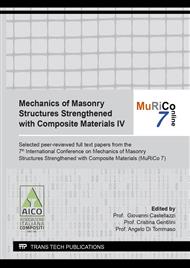[1]
S. R. Ferreira, F. de A. Silva, P. R. L. Lima, and R. D. Toledo Filho, Effect of hornification on the structure, tensile behavior and fiber matrix bond of sisal, jute and curauá fiber cement based composite systems,, Constr. Build. Mater., vol. 139, p.551–561, 2017,.
DOI: 10.1016/j.conbuildmat.2016.10.004
Google Scholar
[2]
D. Asprone, M. Durante, A. Prota, and G. Manfredi, Potential of structural pozzolanic matrix – hemp fiber grid composites,, Constr. Build. Mater., vol. 25, no. 6, p.2867–2874, 2011,.
DOI: 10.1016/j.conbuildmat.2010.12.046
Google Scholar
[3]
J. Szulc, W. Machnowski, S. Kowalska, and A. Jachowicz, Beeswax-Modified Textiles : Method of Preparation and Assessment of Antimicrobial Properties,, p.4–7.
DOI: 10.3390/polym12020344
Google Scholar
[4]
N. Forsman, A. Lozhechnikova, A. Khakalo, L. S. Johansson, J. Vartiainen, and M. Österberg, Layer-by-layer assembled hydrophobic coatings for cellulose nanofibril films and textiles, made of polylysine and natural wax particles,, Carbohydr. Polym., vol. 173, p.392–402, 2017,.
DOI: 10.1016/j.carbpol.2017.06.007
Google Scholar
[5]
M. Oliveira et al., Biodegradable trays of thermoplastic starch / poly ( lactic acid ) coated with beeswax,, Ind. Crop. Prod., vol. 112, no. January, p.481–487, 2018,.
DOI: 10.1016/j.indcrop.2017.12.045
Google Scholar
[6]
A. Lozhechnikova, K. Vahtikari, M. Hughes, and M. Österberg, Toward energy efficiency through an optimized use of wood: The development of natural hydrophobic coatings that retain moisture-buffering ability,, Energy Build., vol. 105, p.37–42, 2015,.
DOI: 10.1016/j.enbuild.2015.07.052
Google Scholar
[7]
D. Balgude, A. Sabnis, and S. K. Ghosh, Synthesis and characterization of cardanol based aqueous 2K polyurethane coatings,, Eur. Polym. J., vol. 85, p.620–634, 2016,.
DOI: 10.1016/j.eurpolymj.2016.03.042
Google Scholar
[8]
A. Gisela Cunha and A. Gandini, Turning polysaccharides into hydrophobic materials : a critical review . Part 2 . Hemicelluloses , chitin / chitosan , starch , pectin and alginates,, Cellulose, p.1045–1065, 2010,.
DOI: 10.1007/s10570-010-9435-5
Google Scholar
[9]
B. K. Tiwari, V. P. Valdramidis, C. P. O. Donnell, K. Muthukumarappan, P. Bourke, and P. J. Cullen, Application of Natural Antimicrobials for Food Preservation,, J. Agric. Food Chem, vol. 57, p.5987–6000, 2009,.
DOI: 10.1021/jf900668n
Google Scholar
[10]
M. Sónia Cristina Pereira, Edible Coatings Based On Chitosan - Beeswax Emulsions,, Universidade Nova de Lisboa, (2012).
Google Scholar
[11]
G. A. F. Roberts, Chitin Chemistry. Houndmills, Basingstoke, Hampshire RG21 2XS and London: The Macmillan Press LTD, (1992).
Google Scholar
[12]
H. Luo, Q. Shen, F. Ye, Y. F. Cheng, M. Mezgebe, and R. J. Qin, Structure and properties of layer-by-layer self-assembled chitosan/lignosulfonate multilayer film,, Mater. Sci. Eng. C, vol. 32, no. 7, p.2001–2006, 2012,.
DOI: 10.1016/j.msec.2012.05.023
Google Scholar
[13]
M. Kathalewar, A. Sabnis, and D. D'Melo, Polyurethane coatings prepared from CNSL based polyols: Synthesis, characterization and properties,, Prog. Org. Coatings, vol. 77, no. 3, p.616–626, 2014,.
DOI: 10.1016/j.porgcoat.2013.11.028
Google Scholar
[14]
I. S. Bayer, D. Fragouli, P. J. Martorana, L. Martiradonna, R. Cingolani, and A. Athanassiou, Solvent resistant superhydrophobic films from self-emulsifying carnauba wax– alcohol emulsions,, Soft Matter, vol. 7, p.7939–7943, 2011,.
DOI: 10.1039/c1sm05710c
Google Scholar
[15]
W. Zhang, H. Xiao, and L. Qian, Beeswax – chitosan emulsion coated paper with enhanced water vapor barrier efficiency,, Appl. Surf. Sci., vol. 300, p.80–85, 2014,.
DOI: 10.1016/j.apsusc.2014.02.005
Google Scholar
[16]
Z. Cui, E. S. Beach, and P. T. Anastas, Modification of chitosan films with environmentally benign reagents for increased water resistance,, Green Chem. Lett. Rev., vol. 8253, 2011,.
DOI: 10.1080/17518253.2010.500621
Google Scholar
[17]
A. Abbass, M. C. Paiva, D. V. Oliveira, P. B. Lourenço, and R. Fangueiro, Insight into the Effects of Solvent Treatment of Natural Fibers Prior to Structural Composite Casting : Chemical , Physical and Mechanical Evaluation,, Fibers, vol. 9, no. 54, p.1–18, 2021, doi: https://doi.org/10.3390/fib9090054.
DOI: 10.3390/fib9090054
Google Scholar
[18]
M. Jumaa and B. W. Mu, Physicochemical properties of chitosan-lipid emulsions and their stability during the autoclaving process,, vol. 183, p.175–184, (1999).
DOI: 10.1016/s0378-5173(99)00086-1
Google Scholar
[19]
O. Cusola, C. Valls, T. Vidal, T. Tzanov, and M. B. Roncero, Electrochemical Insights on the Hydrophobicity of Cellulose Substrates Imparted by Enzymatically Oxidized Gallates with Increasing Alkyl Chain Length,, ACS Appl. Mater. Interfaces, vol. 7, no. 25, p.13834–13841, 2015,.
DOI: 10.1021/acsami.5b01904
Google Scholar
[20]
M. A. Rahman Bhuiyan, L. Wang, A. Shaid, R. A. Shanks, and J. Ding, Polyurethane-aerogel incorporated coating on cotton fabric for chemical protection,, Prog. Org. Coatings, vol. 131, no. February, p.100–110, 2019,.
DOI: 10.1016/j.porgcoat.2019.01.041
Google Scholar
[21]
A. Mohammadi, M. Barikani, and M. Barmar, Synthesis and investigation of thermal and mechanical properties of in situ prepared biocompatible Fe3O4 / polyurethane elastomer nanocomposites,, no. February 2015, 2014,.
DOI: 10.1007/s00289-014-1268-1
Google Scholar
[22]
Ł. Byczyńskia, M. Dutkiewicz, and R. Januszewski, Thermal behaviour and flame retardancy of polyurethane high-solid coatings modified with hexakis(2,3-epoxypropyl)cyclotriphosphazene,, Prog. Org. Coatings, vol. 108, no. April, p.51–58, 2017,.
DOI: 10.1016/j.porgcoat.2017.04.010
Google Scholar
[23]
A. Bahadur, M. Shoaib, A. Saeed, and S. Iqbal, FT-IR spectroscopic and thermal study of waterborne polyurethane-acrylate leather coatings using tartaric acid as an ionomer,, vol. 16, no. 6, p.463–474, 2016,.
DOI: 10.1515/epoly-2016-0154
Google Scholar


